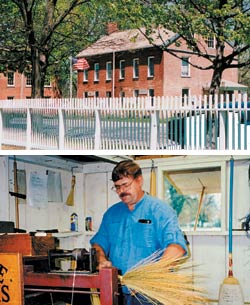Bishop Hill in Illinois: A Historic Landmark With Over 12 Buildings From the 1800s

I first visited tiny Bishop Hill, nestled in the heart of northwestern Illinois farmland, about 35 years ago. Totally charmed by its story, historic buildings and quaint shops, I eventually moved here.
Swedish immigrants seeking religious freedom walked here — 160 miles — from Chicago in fall 1846. Along with more than 1,000 Swedes who eventually joined them, they survived harsh winters and established a thriving, self-sufficient commune, known for superb craftsmanship and farming, before disbanding 15 years later. A few of their descendants still live nearby.
Now a 5-acre National Historic Landmark, Bishop Hill boasts over a dozen of its original 22 buildings, many beautifully restored and converted to museums (we have six!) or shops.
I recommend starting at the south entrance with the Bishop Hill Museum. Its outstanding collection of vivid prints by folk painter Olof Krans, who moved to the colony in 1850 at age 12, help me picture life as it was. It's just a short walk to the Steeple Building — watch for the unusual one-handed clock in the tower–to watch a short video and see exhibits and artifacts in the Bishop Hill Heritage Association Museum.
History Abounds
A walking tour of the village — there are only 125 residents — takes you past a park and gazebo, an herb garden and buildings with fascinating stories.
Take the huge 1848 Colony Church, where all colonists attended twice-daily services, for instance. Not many congregations put their sanctuary on the top floor, but that's what the colony did to provide housing for new families on the floors beneath. Don't miss the sanctuary's handsome original walnut pews or the first-floor museum.
The Bjorklund Hotel, now a museum, once lodged the many visiting journalists, ministers and businessmen. Today, you can stay overnight in Judith and Lowell Gilbert's beautiful 1855 Colony Hospital Bed-and-Breakfast, with original pine floors and furnishings recalling the colony era. (110 N. Olson St.; nightly rates range from $80-$120; 1-309/927-3506.)

And the Colony Store showcases wonderful Swedish gifts and crafts, plus seemingly endless jars of candy! (101 W. Main St.; 1-309-927-3596.)
Other picturesque shops offer unusual antiques… handmade brooms… candles… quilting supplies… and more.
To sample Swedish fare, I highly recommend lunch at the Red Oak Luncheonbord (106 Bishop Hill St.; 1-309-927-3539) or P.L. Johnson's Dining Room (110 W. Bjorklund St.; 1-309-927-3885).
A third restaurant, The Filling Station, offers down-home cooking and the best burgers I've ever tasted at its daily lunches and Friday suppers. It's also open for weekend breakfasts (303 N. Bishop Hill St.; 1-309-927-3355 ).
At holiday time, Bishop Hill glows — literally — during Lucia Nights, with candles in the windows and luminarias along the walkways. “Lucia girls” serve coffee and sweets in museums and shops and holiday music fills the air.
But the holiday starts even earlier with the Julmarknad, or Christmas market, which features old-fashioned decorations, special workshops and Swedish folk characters wandering the streets.
Yes, I'm convinced that there's no place like home–especially when it's Bishop Hill.




Leave a Reply